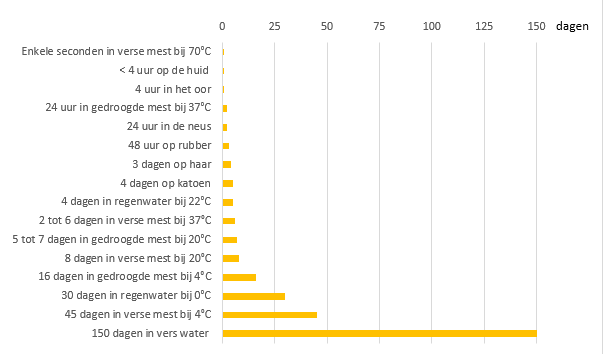- All products are added to your cart.
The Avian Influenza virus (LPAI H3N1) is spreading to an increasingly larger area. How does the bird flu virus manage to spread so rapidly?
The Avian Influenza Virus (LPAI H3N1) is spreading to an increasingly larger area. How does the bird flu virus manage to spread so rapidly?
The latest data on the spread of the bird flu virus LPAI H3N1 shows that in a period of 12 weeks, more than 80 Belgian poultry farms have been affected by the virus. The outbreaks are concentrated in West Flanders, but cases of the bird flu virus have also been observed in the provinces of East Flanders, Antwerp, and Liège. Additionally, the virus has spread to Northern France and Luxembourg. Considering the speed of spread and the transmission route of the virus, it is not inconceivable that it is moving towards the Netherlands. Practical information about the spread and survival period of this type of virus is necessary to minimize the chances of introducing the virus into the Netherlands.
The Avian Influenza Virus, or bird flu virus, poses a significant threat to Dutch poultry farming due to its unfavorable spread and survival conditions. The virus thrives best at cold temperatures. The colder the environment in which the virus is present, the longer it can continue to spread. The virus can survive throughout the entire winter. While many viruses are completely destroyed at temperatures around 37°C, the bird flu virus requires 60°C for complete inactivation. It can persist for an extended period in the ground through the excretion in the feces of an infected bird. In manure at temperatures of 4°C, it can survive up to 45 days, whereas at 37°C, this is reduced to only 2 to 6 days. The optimal pH level for the virus is between 5.5 – 8. See the graph below for a more detailed overview of the survival of the Avian Influenza Virus in different media.

Spread
The spread of the avian influenza virus involves various transmission routes:
- Spread by (wild) birds
Infection with the avian influenza virus can occur through both direct and indirect contact between birds. A distinction can be made between contact among the same species and contact with wild birds. The entry of wild birds into the chicken coop poses a significant risk of introducing avian influenza. This includes pigeons, starlings, or various types of waterfowl that may be infected. Additionally, combining birds from other farms increases the risk of introducing the virus into the coop. Through direct contact between birds, infected animals can spread the virus through the respiratory system, eye fluid, or feces.
- Spread via rodents
Although rodents have never been officially confirmed as vectors of the avian influenza virus, it is still essential to consider them as potential sources of infection. In 2014, the H5 type of avian influenza virus was detected on the snout of a house mouse found dead in a culled coop. However, it was never clarified whether the virus was transmitted from infected poultry to the mouse or vice versa.
- Spread via contaminated material
Human activity also poses a significant risk of infection. The virus can be introduced into the coop through contaminated material such as feed, crates, transport vehicles, and people who have come into contact with the virus through their shoes or clothing. Additionally, data on the survival of LPAI indicates that it can survive for up to 68 hours on human hair. Thorough cleaning and disinfection before entering the coop are, therefore, crucial.
- Spread via the wind
Despite strict biosecurity measures, poultry farms can still be infected with the avian influenza virus, often through the wind. (Traces of) LPAI can attach to dust from an infected coop and be transported through the air to another coop. Research on the possibility of avian influenza spread through the air confirms this. At a wind speed of 6.4 km/h, traces of the avian influenza virus can be found up to 10 kilometers from the original source of infection. At a wind speed of 51 km/h, traces were found at a distance of 15 kilometers from the infection source.
For a more comprehensive overview of research results on the spread of avian influenza through the air, click here.
Biosecurity measures
The combination of persistent survival and various sources of spread makes the avian influenza virus a significant challenge for farmers. Biosecurity is the only way to stop the spread of the avian influenza virus on and around poultry farms. Farmers should strive for the highest possible levels of biosecurity.
The main route of spread to poultry farms is likely the transport of infected live birds, contaminated carcasses, or litter from vehicles. This emphasizes the importance of biosecurity protocols focused on cleaning and disinfecting vehicles. However, the risk of contaminated vehicles or equipment can be extremely dangerous to the health of animals, leading to financial consequences for the farm.
Additionally, prevent spread by the wind. Reduce the chance of spreading fertilizers in the coop, as avian influenza may be associated with them. Spraying Virkon™S in poultry farms can help reduce cross-contamination and prevent secondary infections during avian influenza outbreaks. Virkon™S can be sprayed in the presence of livestock in a solution of 1:200 (0.5%).
For a detailed disinfection plan with Virkon™S to prevent/combat (introduction of) low-pathogenic avian influenza (LPAI), download the brochure. For more information, contact info@zoolac.nl.
---
Image source: CardIrin/shutterstock.com


